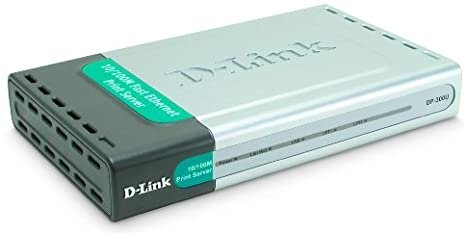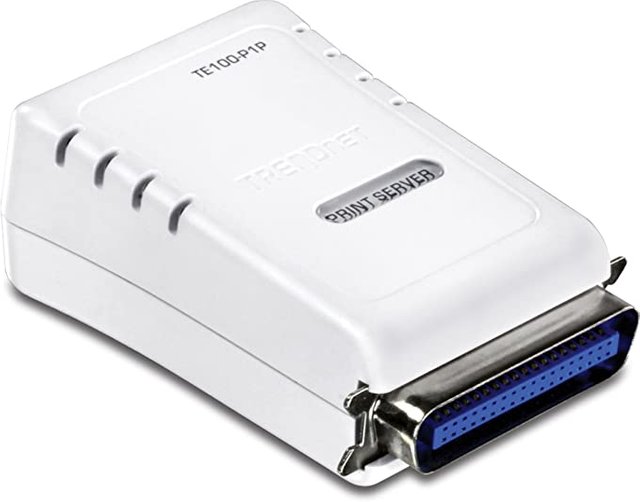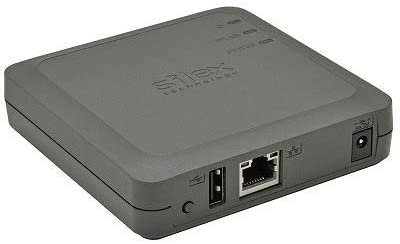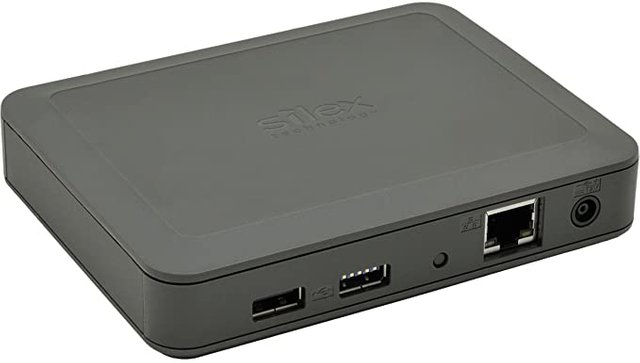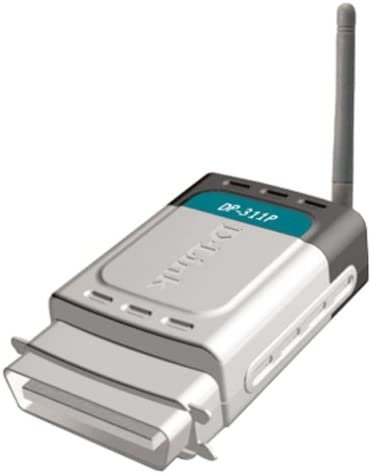D-Link DP-300U 10/100TX 1-USB Port 2-Parallel Port Print Server
Top Reviews:
First I tried the NetGear PS101 print server. I liked the spiffy form factor. I could talk to the print server admin web interface and get it to print a test page, but even after many, many hours could never get it to print a document. So I returned it.After that debacle, I decided to splurge for the HP JetDirect. At first I could only get it to print the configuration page. A visit to the HP support forums turned up lots of references to the JetDirect not working with SP2 and the suggested solution was to uninstall SP2. Ugh. Finally I went to the D-Link web site and copied the D-Link installation guide for XP w/SP2. The main difference was that D-Link suggested installing the print server as a local TCP/IP printer instead of a networked printer and, bingo, I got the JetDirect to print. (NOTE: It still goes over the network, it just looks local to the PC.) However I was miffed that I paid double the price for a device which required a competitors documentation to get to work. In addition, DHCP didn't work and I could never get it to show up in my network neighborhood.So ... in a possibly nonsensical move of principle and price, I bought the D-Link DP300U and set up it. It's not trivial to install, but after working with the other two devices, a couple hours of install time seems like nothing. Here are a couple tips ...(1) Do NOT use DHCP. Use a fixed IP address. Unlike the JetDirect, DHCP works. However, it still didn't show up in my network neighborhood and now I didn't know the IP address. There is NO HARDWARE RESET on the device. The D-Link support guy was great. He told me that if I couldn't find the IP address, I would have to send it back to D-Link to be reset (Ugh!). The good news is that he told me how to find it. I went to the router and looked at the DHCP assignment list and got it, and then reset the thing to a nice, fixed IP address in my subnet.(2) I first set it up as per the instructions as a local TCP/IP printer, which means it's still on the network but looks like a local printer to the PC. It worked OK, but did this weird, long pause ... about a minute ... right in the middle of long documents. Again D-Link support was good. They told me to try setting it up as a networked printer, which I did. Unfortunately, this doesn't have spooling and you're back to 1980's wait-for-printing. Then something weird happened that I can not explain ... after setting up the device as a networked printer, I went back to the local TCP/IP printer that I had set up and it worked perfectly. Don't know how it got fixed.My PC is a Dell laptop w/ wireless connection to an access point, and then wired to a router and the print server. My printer is an HP Deskjet 5550.So, in the end I'm sticking with the D-Link product and I am happy with it. I would have rated it 3 stars as an overall product, but bumped my rating to 4 stars because I still thought it was the best of the ones I had tried. The itty-bitty-print-server market could use some improvement.Enjoy!
It does work and as stated in other reviews, the ports are labeled backwards. Good tip, it saved me a real headache. You have to know networking to set it up, I wouldn't recommend it to a novice. The product photo is incorrect but the description is correct.
The DP300U setup is convoluted. You need to disconnect one of your network PC's from the network, connecting the printer through the print server to that PC and then change its IP configuration to match the default of the DP300U in order to change to your own network configuration plan. That was ok, BUT, you can't print from a DOS application to your printer. I was using XP Pro w/an HP 4L and there are instructions on how to use the "net use" command to make use of lpt1 or 2 but it doesn't work. It's nice that they have a voice help line available. It would be nicer if they plain 'fessed up to the fact that it doen't work the way they have designed their print server. First it was call the hardware company (HP). Then it must be an error with the Win XP Pro software and finally it was "we don't support that issue here at the help line". That was close to "it really doesn't work with DOS" but it would have been nice if the documentation didn't lead you to believe otherwise. This admission came after a panicked conference with the second level who wouldn't come to the phone but was clearly calling the shots. Guys, just say you constructed the thing without regard to DOS. My HP2500 Color laser w/internal print server can be accessed as lpt1 from my setup but not the D-Link DP 300U (i.e. no problem with HP or WinXP). What to do? Ahah!! Put a manual switch between the printer and the D-Link Print Server. Leave the network connected to the printer until you need to use it in DOS mode, flip the switch, the same print properties setup will print to the monochrome printer and all is well. I know the older conventional wisdom was don't put manual switches between PC's and laser printers, but this has worked for me and the HP4L for years (knock on wood) in other configurations as well.
TRENDnet 1-Port Parallel Print Server TE100-P1P
Top Reviews:
Bought from a private seller off Amazon.comAfter reading other Amazon.com reviewers, I was aware this would not be a "novice level" device to install. However, I felt I had enough of a basic understanding for setting the IP address as detailed by other TrendNet owners. I simply copied the IP Addresses used one then by the second of two reviewers. More later on why I changed it.I bought this to install on an HPLaserJet 5 and was aware this device needed an extension parallel printer cable as described by another Amazon.com review. However, I chose to wait for the TrendNet Server to arrive before getting the cable.MOUNTING "NAKED" WITHOUT THE PARALLEL EXTENSION CABLESoon after the TrendNet server was delivered, I felt it best to check if it was working right away and accomplished this without the extension cable.On the HPLaserJet 5 printer, the parallel cable exits the HP case with a snug fit. That is the TrendNet Server does need this extension cable. Being without one, I removed the TrendNet Server case and plugged it in. So I have an operational but "naked-caseless" device.The case is not difficult to remove. It has one screw under the top of the label and then must be squeezed to disengage two plastic hooks that snapped the case together. The label is very sticky and must be slowly pulled away.FRAGILENESS?Regarding it's fragility when mounted "naked" with out a case? The printed circuit board is thick and quite sturdy. Upon inspecting, the TrendNet case serves to keep the circuity clean from dust and cover the exposed ciruits. Even if the cover were left on, the majority of the mechanical stress appears to be borne by the circuit board and the cover is "protective dressing."When I put the HPLaserJet 5 printer cover back on, it adds rigidness by holding the circuit board in place. Of the HP cover could be trimmed a tad to make a perfect fit. The printed circuit board is 99% inside of covered the HP printer case, so at this point I will not get a parallel extension cable referred to earlier.WHY TWO DIFFERENT IP ADDRESS CHANGESWith one router, it worked as I wanted it to. The laptop was able to print to the remotel located printer. However, I later installed a 2nd router plugged into the first router and ran into IP addressing issues. The routers use different IP address ranges.Computers attached to the second router can use the printer. But the laptop attached to the first router cannot anymore. I found solutions to my dilemma on the internet. I've not gone back to fix that. For those wanting to know, I have to make the 2nd router a switch. That's for another day.
For years our HP 2300 laser printer was connected by a USB cable to one computer. Other computers could print from it as long as the computer was on and connected to the network. Once the computer turned off the printer was no longer available for other computer users in our home. Fortunately a parallel port also is on the printer behind the access door. The Trendnet unit in theory connects to the parallel connector. The reason I say in theory is on my printer the connector port does not have enough room for the Trendnet device that is kind of bulky and it necessitated buying an extension cable to plug in first, then on the other end make the Trendnt connection. Be sure to get a 36pin M-F cable extension if you need it. Once that problem was solved the rest was easy. Connect an ethernet cable into the device and the other into your router. Connect the power cord (this unit is not wifi enabled). Then open the printer box to add the printer. it will show up as a series of letters and numbers first. Add it and then rename it to whatever you want. On a Macintosh the utility software is not needed (it doesn't run on a Mac anyway as it Windows based.Ureka. My laptop and other computer connected by wifi to the router all see the printer. Now it does not matter if the main computer is on or off. Just keep the printer always on. Printing is a breeze. It also recognizes the duplex capanility on my printer for double sided printing.I give it 4 stars and nor 5 because I had to buy another cable from Amazon to get it to work. it is a little slower to print but that is a minor issue. Once the job spools it goes fast.
I have an older laser printer (NEC Superscript 870) which has been bulletproof for many years, but it only has a parallel port. I had connected to it prior via another parallel port print server device (D-Link DP-301P+), but it was behaving erratically in recent months. I don't normally buy TrendNet products but wanted to give this unit a try since the price was comparable and the other reviews seemed positive. It installs very much the same as the D-Link, and one needs to create a TCP/IP port on their Win machine in the same way. It has worked flawlessly for the few weeks I've had it. It does take some minor geekness to get it fully up and running, but if you follow the directions carefully you should be good to go. I am now again printing to my undying laser printer over my house network with both Windows and Apple machines.
DS-520AN 802.11n Wireless and Gigabit Ethernet USB Device Server
Top Reviews:
I purchased this so that I could wire my GPIB interface of my lab equipment up so that I no longer need a workstation at the bench. This allowed me to use several devices wirelessly with little problem. The setup was rather simple, and my Windows 10 PC does in fact see the USB devices as if they were wired in directly. No latency problems with this either.
DS-600 Gigabit USB 3.0 High Throughput Device Server
Top Reviews:
Pro: Configuration and client software solid, consistent and easy to understand. You will actually get product support if you contact Silex, and actually somebody who can answer technical questions. Device allows multiple computers on the LAN to share any of our USB software key, and also allowed me to configure misc. hardware computer and communications equipment (Motorola XPR4550 radio, XPR/SLR repeaters, etc., except Hytera repeaters).Con: I wanted to place some at remote offices that are connected via Internet, through a local and remote firewalls. While it allowed to to log into the device for configuration, USB hardware keys (and likely everything else) would not be recognized by the desktop app (received a network error). Even after forwarding all the ports that Silex indicated it uses on the LAN. However, Silex never committed that this would work - I just wanted to verify this. It will work over a bridged VPN connection where both networks share a broadcast domain. As of Oct 2018, no off the shelf device exists to do this except by using a RasberryPI and VirtualHere CloudHub. This product appears just as solid as Silex...As you have to home-brew an internet-capable device, Silex might consider modifying their protocol to allow this.
I bought 2 of these.They do exactly as advertised. A reviewer saying it only supports FAT32 i think is incorrect. I've tested with NTFS and exFAT. All the devices i've connected work well, but i did run across an old Microsoft webcam they didn't come up. Amazing that my Oculus Quest connects fine through it. I've only done file transfers, but it seems to work fine. I haven't tried my Quest 2 or a link cable connection yet, but when i do i'll update this review.I'm a pro IT tech and have worked with lots of software and computer connections over the years. I'm impressed with how well the software utility works. I've tested this with Windows 10 Pro and Server 2012 R2.
I own 2 and this device runs mutiple usb 3 hard drives and usb to serial adapters. I also have the usb 3 port hooked up to a 4 port usb 3 hub for added support. Works great!
D-Link DP-311P Wireless Print Server, 1-Centronics Port, 802.11b, 11 Mbps
Top Reviews:
I got this product recently, before I purchased it, I viewed some negative reviews on this DP-311P, but I still bought it and tried it out, it took me only about 10 minutes to finish. The user manual sucks, doesn't tell you very detailed what to do with different network situation, that is why some customers don't know what to do if they are not using D-Link wireless router. First, you need to change the IP address on one of your computers which has a wireless adapter to 192.168.0.XX with subnet mask 255.255.255.0 which means change the computer's IP same as DP-311P default IP scheme, so you can communicate with it. Remember before you do it, set the little switch on the back of 311P to "configure" position. After you changed the computer's IP, use either the wireless adapter connection wizard, or use ad-hoc to connect to 311P, then start IE/browser to access 192.168.0.10, you will see the configuration interface, from there you change the network settings to your existing network scheme (e.g. change IP address to 192.168.1.10 if you have Linksys router...), as well as the wireless settings. Some customers said 128bit encription deson't work, you have to change everything to 64bit, that is not correct. I sucessfully set it to use 128bit without any problem. Instead of using browswer to access the interface, you can also install the ps admin software come with the CD, start the program, it will find the server, you will be able to change all above settings within the program interface. After finish, remember set the back switch to "normal" position. Now, change your computer's IP back to original. Now your Print server should be ready to use. To add the printer, go to control panel and add printer from there, change the port to D-Link printer port and specify the IP address you gave the print server, such as 192.168.1.10. Print a test page, you are done. It is very easy.
Free from cables my Printer is. Setting this up was a little trickey/different than what I expected, but was easily figured out when I followed the instructions. The setup was over in about 10 minutes and I was able to print the first time we tried. Setting up new computers was also laid out step-by-step by the instructions so you don't do anything wrong.Very straight forward and well documented. Thanks to D-Link.
Fast delivery, great product.
